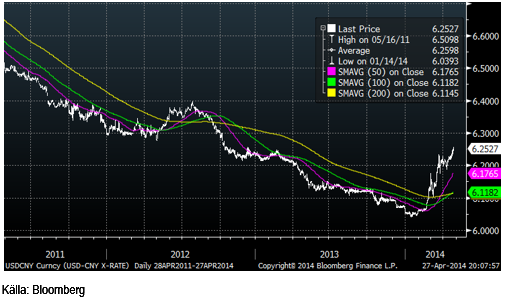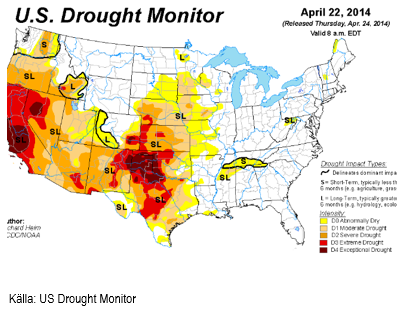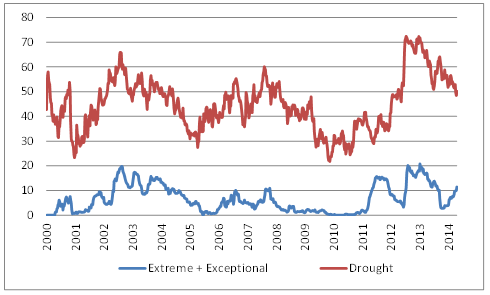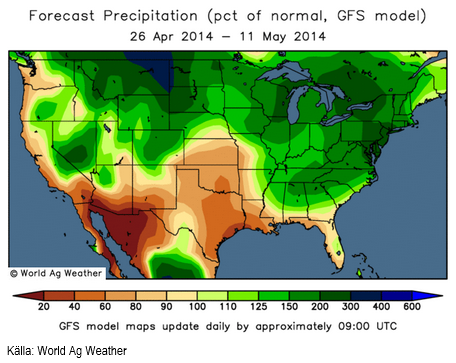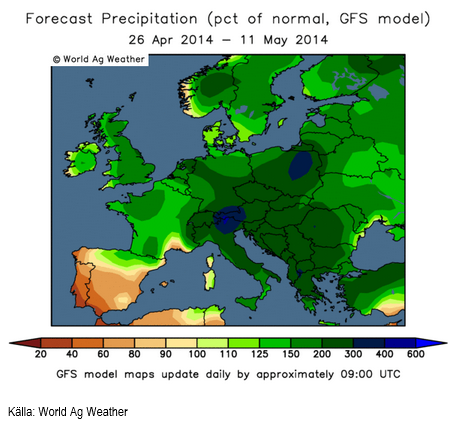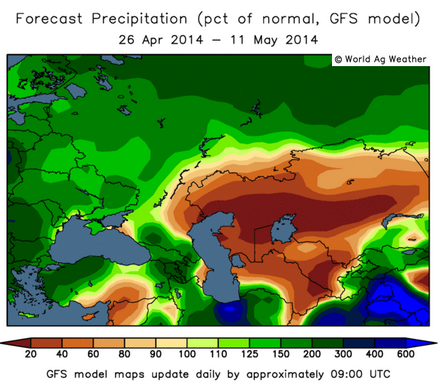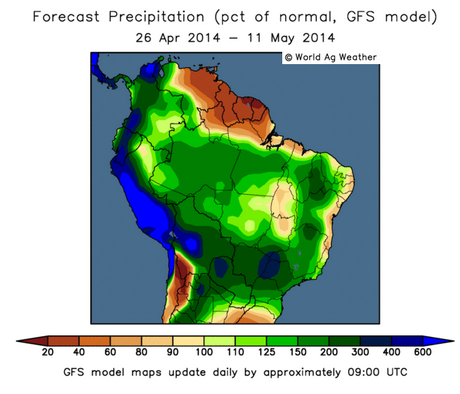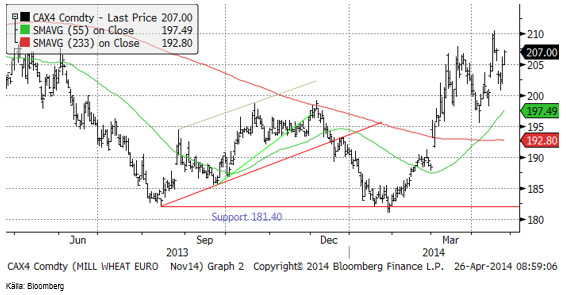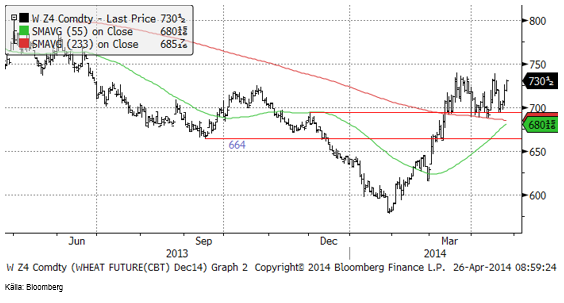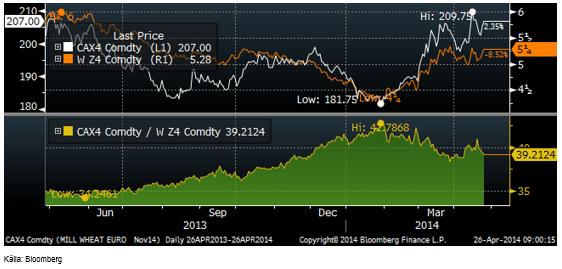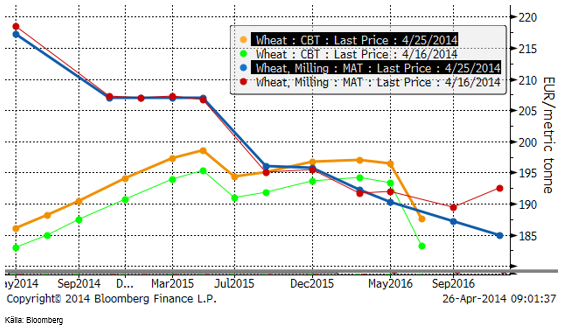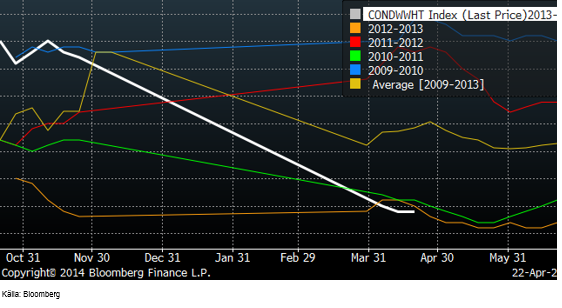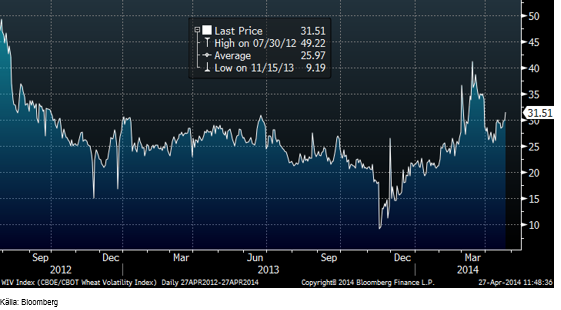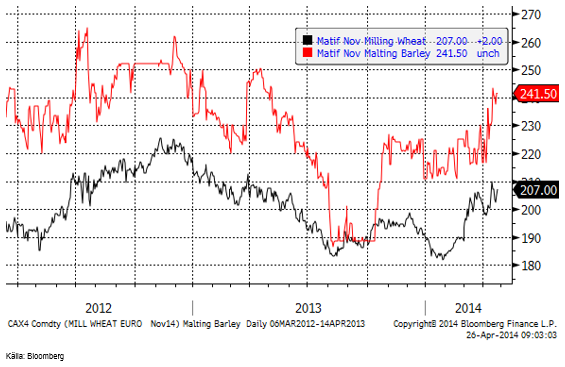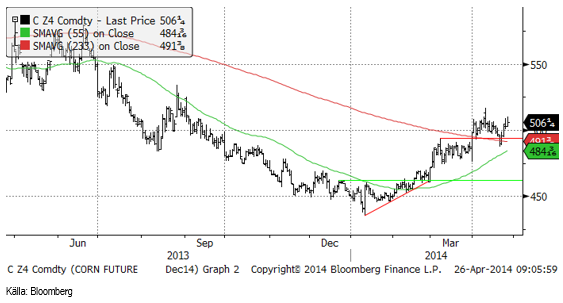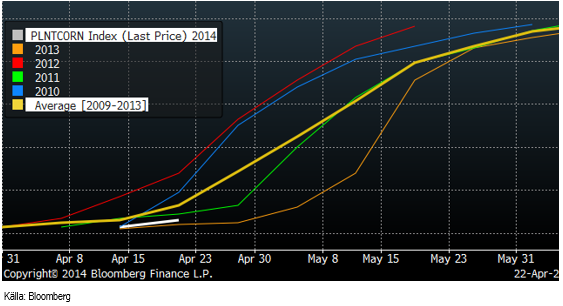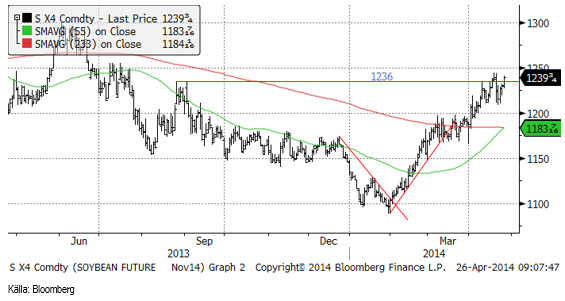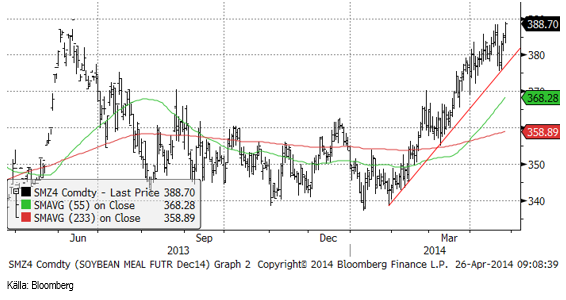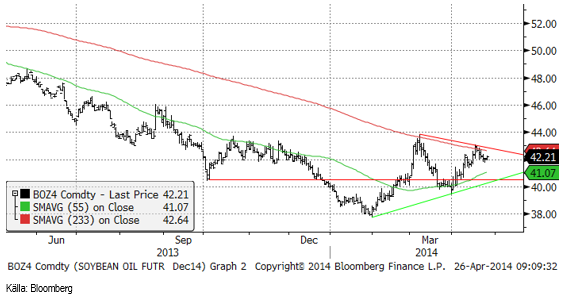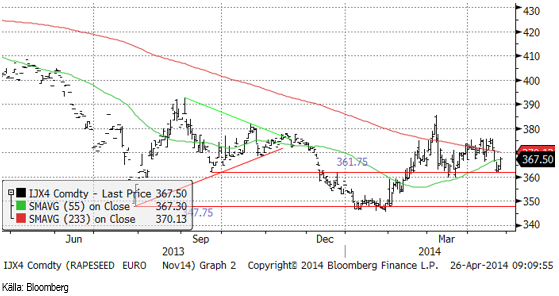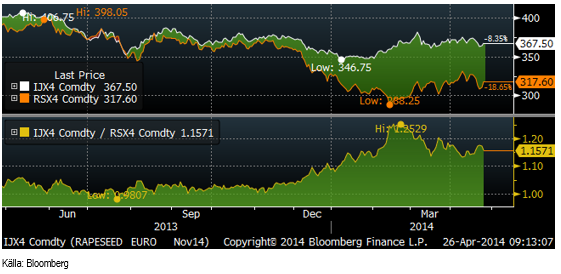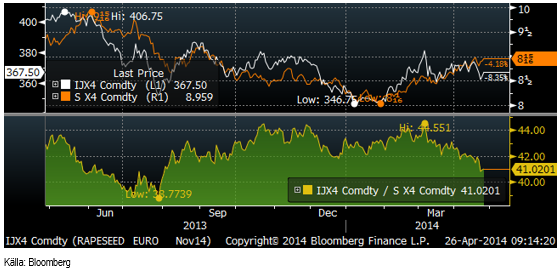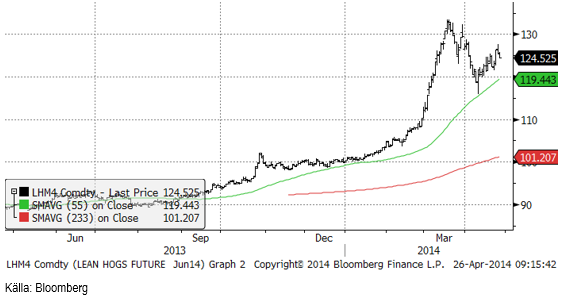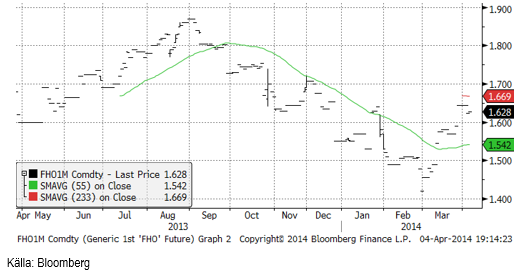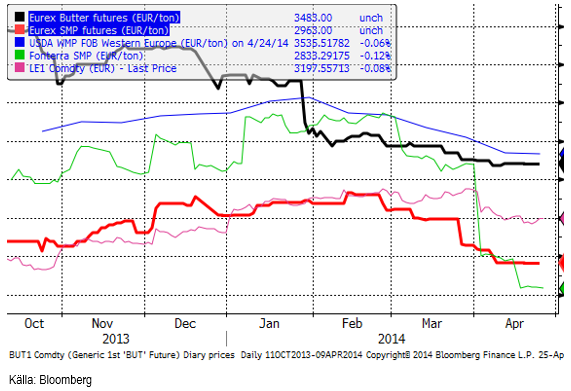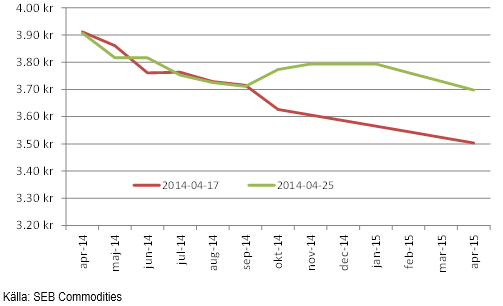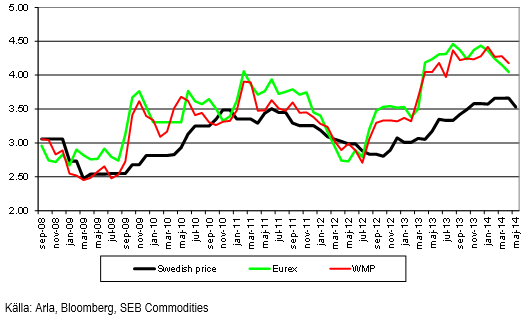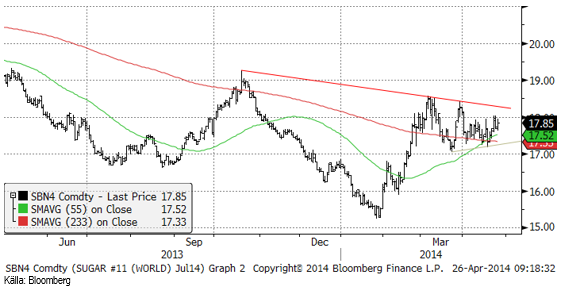Analys
SEB Jordbruksprodukter, 28 april 2014


 Rapsfrö av gammal skörd rasade med 7% på Matif i veckan. En annan stor förlorare var potatis med -11%. Matifs veteterminer var oförändrade, medan Chicagos steg med ett par procent, vilket speglar trenden i den väntade skördens storlek.
Rapsfrö av gammal skörd rasade med 7% på Matif i veckan. En annan stor förlorare var potatis med -11%. Matifs veteterminer var oförändrade, medan Chicagos steg med ett par procent, vilket speglar trenden i den väntade skördens storlek.
Arla annonserade den första egenliga sänkningen av avräkningspriset inför maj månad. Det är dock inte alltid som spotpriser är de som rör sig mest. Terminspriserna på mjölk basis SMP och smör på Eurex steg rejält för leveransdatum från hösten och framåt. SEB, som ”bättrar” Eurex köpkurs med 1%, betalar i genomsnitt 3.82 öre per Kilo per månad april 2014 – april 2015.
Inköpschefsindex för tillverkningsindustrin i Kina kom in på 48.3 i april, upp insignifikant från 48 i mars. Ett PMI under 50 innebär att tillverkningssektorn krymper, eller kommer att krympa, eftersom PMI är en framåtblickande indikator. Siffran fick renminbin (CNY), Kinas officiella valuta, att falla ytterligare mot andra valutor. Att allt inte står rätt till i Kina ser man av att den stadiga trenden av starkare valuta bröts i slutet av februari. Sedan dess har valutan försvagats hastigt. En svagare valuta gör att importvaror, som t ex sojabönor blir dyrare, vilket sänker efterfrågan. CNY/USD har gått från 6 till 6.25 sedan början av året.
Odlingsväder
Indien har varit ovanligt torrt och förväntas fortsätta vara det. Kina väntas få normalt väder på veteområdena norr om Peking, men söderöver väntas det fortsatt komma mindre nederbörd än normalt.
Torkan i USA håller sig kvar, som vi ser av den senaste US Drought Monitor nedan.
Sedan den 25 mars har andelen av USA:s yta som är torrare än normalt minskat från 52% till 50%. Däremot har andelen som är drabbade av de två värsta klassificeringarna ökat från 9.7% till 11.5%. Torrast är det i det nordvästra hörnet av Texas.
Nederbördsprognosen enligt GFS-modellen visar att Sydvästern fortsätter att få mindre nederbörd än normalt de kommande två veckorna. Vetet är i dåligt skick i dessa områden. Där sojabönor och majs odlas ser vi att det kommer mer nederbörd än normalt, de kommande två veckorna. Kalifornien ser ut att få normal nederbörd, vilket faktiskt är ovanligt.
Europa fortsätter att få gott om nederbörd i stort sett överallt. ”Rain makes grain”. Det ser allt mer ut som om EU-28 kommer att få ett mycket bra odlingsår.
Av den här kartbilden ser vi att Ryssland och Ukraina väntas få rikligt med nederbörd de kommande två veckorna. Kazakstan ser dock betydligt torrare ut.
Även Sydamerika har i stort sett gott om nederbörd, i synnerhet där det har varit torrt i Brasilien förut. Norra Argentina väntas vara fortsatt torrt.
Australiens Meteorologiska byrå säger att sex av sju klimatmodeller passerar nivån för El Niño i år, med ganska hög sannolikhet att detta inträffar redan i juli. Detta kan sänka skörden i Australien med 10 mt ton vete om El Niño håller i sig under hösten och vintern. En tidig effekt kan också ge mindre nederbörd över Dakota-staterna i USA, vilket dock inte påverkar skörden av vete där negativt, eftersom den redan är klar. Skörden av majs lite längre österut i de nordliga delstaterna av USA kan dock påverkas, men El Niño påverkar USA endast lokalt mitt i landet i de allra nordligaste delstaterna. I resten av världen kan noteras att även Indonesien brukar bli torrt, där det bland annat odlas robusta-kaffe av betydelse för globala balanser och palmolja, också av betydelse för globala balanser. El Niño kommer alltså med all sannolikhet minska global produktion av vete med ca 10 mt (Australien), palmolja och robusta kaffe.
Vete
Vetepriset har stigit i veckan pga oro för vädret i USA och framförallt för ökad oro för utvecklingen i Ukraina. Överenskommelsen i Geneve bröts nästan genast. Marknadens oro för Ukraina har huvudsakligen kanaliserats till högre pris på vete och endast i mindre del till högre pris på majs. Detta är underligt, eftersom 95% av Ukrainas veteproduktion är höstvete och alltså redan sått sedan länge och knappast i fara vid en förvärrad konflikt. Rapporter från Ukraina säger dessutom att vetet och kornet (en annan stor gröda där) är i utmärkt skick. Ukraina är världens 6 eller 7 största exportör av vete, men tredje störst på majs. Av de frågor vi får från media och placerare, är det uppenbart att kunskapen om vad Ukraina odlar och säljer inte är så väl spridd, då de flesta tycks tro att det är vårvete.
Dessutom handlar diskussionerna om hur EU och västvärlden kan hjälpa Ukraina till stor del om frihandelsavtal som verktyg för hjälpen. I Bryssel kommer förslaget att ta bort tullen på varor importerade från Ukraina och det kommer säkerligen att klubbas igenom, eftersom det sänker matpriserna i EU, samtidigt som priset just nu inte är så lågt att lantbrukarna i EU lider av det. IMF sammanträder den 30 april för att besluta om ett stödpaket till Ukraina. Det borde alltså inte finnas någon grund för oro för mindre utbud av vete från Ukraina. Skörden kommer att bärgas, den kommer att vara mycket stor (av vete) och den kommer att gå på export. Och detta kommer inte att gynna Ukrainas statskassa alls, eftersom lantbruk i Ukraina är skattebefriat.
Tekniskt är priset på novemberkontraktet på Matif i positiv trend, men kraften i uppgången har avtagit. Priset på terminerna är tillbaka på samma nivå som för ett år sedan och som vi ser det är priset ”högt”. Det senaste året har skörden handlasts i intervallet 182 – 210 euro. Det borde vara intressant för lantbrukare att successivt prissäkra de här nivåerna mellan 205 och 210 euro.
Chicagovetet (december) har fått stöd på 700 cent och ligger mellan 700 och 740 cent just nu. Detta prisintervall kan vara antingen toppen efter uppgången från 550 cent, eller en andhämtningspaus inför ytterligare en prisuppgång mot de gamla topparna upp mot 800 cent. Man ska komma ihåg att vetepriset i USA är lägre i USA än i Europa. Samtidigt som Europa kommer att få en av sina största skördar någonsin, kan USA få en av sina mindre pga den pågående torkan.
Chicagoterminerna fortsätter att vinna tillbaka mark mot Matif, just på grund av att USA har sämre väder och EU-28 så nära perfekt att man inte bör klaga, samtidigt som Matif är dyrare än Chicago. Vi tror att detta kommer att fortsätta. Kvoten mellan priserna (omräknade till euro) är 39 mot 35 för ett år sedan. Det finns fortfarande goda möjligheter för Chicagovetet att stiga mer än Matifvetet.
Stats Canada rapporterade areal för vetet i veckan. Det var 24.8 miljoner acres, vilket var mer än marknaden hade väntat sig, dock 5% mindre än förra året. Eftersom Kanada inte lyckats exportera så värst mycket av förra årets rekordskörd, blir det en rekordstor ingående balans på det nya året. En hög ingående balans påverkar utbud och efterfrågan precis lika mycket som ny skörd.
Indiens skörd justerades ner i veckan till 96 mt, vilket ändå är högre än förra året (USDA 93.51 mt).
EU-28 har gett ut exportlicenser för 24.663 miljoner ton ”soft” wheat sedan den 1 juli förra året när marknadsföringsåret 2013/14 började, till och med den 22 april, rapporterade Europakommissionen i torsdags. Exporten är 49% högre än förra året och redan betydligt högre än förra årets slutsumma.
Egypten och Turkiet har nu vete så det räcker till långt efter skörden. Såväl den rumänska som den franska skörden lär bli mycket hög. StrategieGrains upprepade i veckan ett skördeestimat för EU-28 på 137 mt. Förväntningar på en hög skörd och det faktum att importländerna i stort sett har köpt färdigt bör sätta press på de höga priserna på korta terminskontrakt.
Nedan ser vi terminskurvorna för Chicagovete och Matif i fredags och veckan innan.
Måndagens crop condition rapport för vete visade att vetet i genomsnitt för de 18 delstater som producerar mest vete i USA per den 18 april låg oförändrat på 34% i ”good” och ”excellen condition”. Spridningen är stor, där Oklahoma har 11% i ”good” och inget i ”excellent”. Texas har 11% ”good” och 1% ”excellent”. De som har bäst vete just nu är Idaho (87% good/excellent) och Kalifornien 80%. Flera delstater har över 60% i good/excellent.
CBOE/CBOT:s Wheat Volatility Index som mäter vilken nivå på volatilitet som marknaden prissätter optioner till, har stigit till en högre nivå än vad som noterades under hela förra året. Den ligger just nu på 31.5% volatilitet och den lägsta nivån förra året var 9.19%. Uppgången i handlad volatilitet återspeglar inte hur mycket marknaden rör sig. Det återspeglar en oro för hur marknadspriset kan komma att röra sig de kommande månaderna. En hel del av den här volatiliteten är nog en riskpremie och det är antagligen bra värde i att sälja volatilitet, genom att utfärda optioner.
Vi behåller neutral vy basis Matif, dock på gränsen till säljrekommendation. För Chicago är vi som framgår något mer positiva (men fortfarande inom ”neutral-spektrumet”).
Däremot är handlad volatilitet för optioner relativt hög. Vi anser att optionsmarknaden tar höjd för en oro som är överskattad. Vi rekommenderar alltså att man försöker sälja uppsida via utfärdande av köpoptioner (vilket kan vara en bra strategi för naturliga säljare av vete) och att naturliga köpare av vete försöker utfärda säljoptioner (ger någon annan rätten att sälja till utfärdaren till ett (lågt) lösenpris) och i gengäld erhålla en betalning för optionen nu.
Maltkorn
Maltkornsterminerna steg ordentligt i veckan och ligger nu 34 euro över Matifs vetetermin för november. För två veckor sedan var skillnaden 30 euro.
Majs
Decemberkontraktet på majs steg i veckan till en ny årshögsta rekylerade ner efter att varit uppe mot 520 cent. Sådden i USA ligger efter pga det kalla och blöta vädret, men vi anser att detta inte är något att oroa sig för än så länge eftersom den positiva effekten av regn kanske till och med väger över till en fördel.
Den andra plantings-rapporten för året, från i måndagen 21 april visade att 6% av majsarealen i USA var sådd per den 18 april. Kommentatorerna var snabba att påpeka att detta är sent, men det är faktiskt inte alarmerande sent. Förra året var 4% sått så här dags och det normala är 13%.
Majs är den enda gröda av de tre stora, som inte återhämtat hela prisfallet under förra året. Såväl vete som sojabönor är tillbaka på samma pris som de hade för ett år sedan.
Vi går över till neutral rekommendation för majs.
Sojabönor
Novemberkontraktet på sojabönor i Chicago bröt motståndet på 1236 cent. Nästa tekniska motståndsnivå är 1250. Tekniskt stöd finns vid 1200 cent.
Kina annullerar kontrakt på köpt soja från USA. Inköpschefsindex för tillverkningsindustrin i april i Kina kom in 0.3 enheter högre än i mars på 48.3. Inköpschefsindex under 50 innebär att tillverkningsindustrin krymper och siffran visar att Kinas problem med tillväxten fortsätter. Marknadsbedömare sade i veckan att Kinas intresse för ny skörd också har minskat.
Sojamjölet fortsatte upp ett par dollar i veckan, men ”borde” ur ett tekniskt perspektiv ha stigit färdigt.
Sojaoljan steg initialt, men backade sedan tillbaka.
Sådden av sojabönor brukar komma igång i slutet av april och början av maj. I år är det stora skillnader mellan de södra och norra delarna av landet, där de södra kan komma igång tidigare och de norra lite senare än normalt.
Tekniskt ser det ut som om styrkan i sojamarknaden kommer att mattas men vi behåller neutral som rekommendation för soja.
Raps
StatsCan rapporterade 0.7% lägre areal canola (19.8 miljoner acres) än förra året. Utifrån USDA:s prospective plantings för USA som visade en mycket större areal canola är detta nog en besvikelse. För de som fokuserat på den sena våren i Kanada är nog inte förvånade. Men det verkar som om arealen istället gått till andra oljeväxter, som sojabönor och lin. Totalt sett ökar arealen av oljeväxter i Kanada. Dessutom verkar det vara mer regel än undantag att ”intentions” underskattar den slutliga arealen av canola varje år.
Novemberkontraktet på Matif föll i veckan ner till det tekniska stödet på 361.75 euro och studsade där.
Skillnaden mellan kanadensisk canola i eurotermer och Matifs rapskontrakt (båda för novemberleverans) ligger kvar kring 15%. Det är alltjämt en hög premie för Matifs raps, som vi fortsatt gärna vill vara sålda.
Nedanför ser vi kvoten mellan rapsfrö (november) och sojabönor (november, omräknat till euro. Kvoten har fallit från 42 till 41 på två veckor. Ur detta perspektiv börjar raps bli ”billig” i förhållande till sojabönor.
Vi går nu ur säljrekommendationen för raps och går över till neutral rekommendation.
Potatis
Potatis för leverans i april nästa år sjönk har rasat de tre senaste veckorna. I början av april handlades den kommande skörden till 14.50 euro per dt. I fredags var priset nere under 13 euro, men stängde på 13.20 i fredags kväll.
Gris
Juni-kontraktet på amerikanska lean hogs har fortsatt att rekylera uppåt. Vi noterar att uppgången skett med påtagligt mindre momentum än tidigare under året. Det är ett tecken på att marknaden står inför ett nytt, kraftigt och stort prisfall, som förmodligen går ner till 110 cent.
Spotkontraktet på EUREX Hogs som för två veckor sedan stod i 1.63 euro per Kg har nu stigit till 1.685 euro. Prisuppgången i Europa har skett på förhoppningar om att exportstoppet efter ASF ska tas bort och det finns utrymme för en del besvikelser. Priset har gått upp lite för fort och lite för mycket, tycker jag.
Mjölk
I fredags kom nyheten att Arla sänker avräkningspriset på mjölk i maj med 13 öre per Kg till 353.1 öre per Kg. Arla hänvisar till det kraftiga prisfallet på industrimarknaderna som vi sett den senaste tiden. Dessa tycks nu paradoxalt nog ha hållit sig stabila i april, som vi ser av diagrammet nedan. Men detta är inte allt.
Terminspriserna för leverans efter sommaren har handlats upp extremt kraftigt de senaste två veckorna. Uppgången är drygt 20 öre per Kg mjölkråvara för terminer från oktober till april nästa år.
Detta innebär att genomsnittliga priset för ett Kilo mjölkråvara basis Eurex SMP och smörterminer för perioden april 2014 till och med april 2015 är 3.78 kronor. Det är en uppgång från 3.67 (+3%) på två veckor.
SEB förbättrar börsens köpkurs med 1% (så länge marknaden är på introduktionsstadium och i behov av stöd enligt vår uppfattning). Detta innebär att SEB betalar i genomsnitt 3.82 öre per Kilo per månad april 2014 – april 2015.
ARLA:s avräkningspris för maj sänktes som nämnt ovan med 13 öre och den förändringen är inlagd i nedanstående diagram. Vi ser att Eurex har varit snabbast med att reagera på marknadssignalerna och sjunkit med nästan 50 öre från toppen vid årsskiftet. USDA:s notering för helmjölkspulver (WMP) noterades också lägre i april. Arla, som alltid släpar lite efter, har gjort sin första sänkning nu, för kommande månad.
Socker
Priset på socker ligger kvar i konsolidering mellan 17 och 18.50 cent. Det är ett prisintervall som etablerades i början av förra månaden. Brasiliens skörd har kommit igång och nu rapporteras alla större bruk ha startat, samtidigt som det regnar på sina håll.
Vi går tillbaka till neutral vy på socker från tidigare sälj.
[box]SEB Veckobrev Jordbruksprodukter är producerat av SEB Commodities Sales desk och publiceras i samarbete och med tillstånd på Råvarumarknaden.se[/box]
Detta marknadsföringsmaterial, framtaget av SEB’s Commodities Sales desk, har upprättats enbart i informationssyfte.
Även om innehållet är baserat på källor som SEB bedömt som tillförlitliga ansvarar SEB inte för fel eller brister i informationen. Den utgör inte oberoende, objektiv investeringsanalys och skyddas därför inte av de bestämmelser som SEB har infört för att förebygga potentiella intressekonflikter. Yttranden från SEB’s Commodities Sales desk kan vara oförenliga med tidigare publicerat material från SEB, då den senare hänvisas uppmanas du att läsa den fullständiga rapporten innan någon åtgärd vidtas.
Dokumentationen utgör inte någon investeringsrådgivning och tillhandahålls till dig utan hänsyn till dina investeringsmål. Du uppmanas att självständigt bedöma och komplettera uppgifterna i denna dokumentation och att basera dina investeringsbeslut på material som bedöms erforderligt. Alla framåtblickande uttalanden, åsikter och förväntningar är föremål för risker, osäkerheter och andra faktorer och kan orsaka att det faktiska resultatet avviker väsentligt från det förväntade. Historisk avkastning är ingen garanti för framtida resultat. Detta dokument utgör inte ett erbjudande att teckna några värdepapper eller andra finansiella instrument. SEB svarar inte för förlust eller skada – direkt eller indirekt, eller av vad slag det vara må – som kan uppkomma till följd av användandet av detta material eller dess innehåll.
Observera att det kan förekomma att SEB, dess ledamöter, dess anställda eller dess moder- och/eller dotterbolag vid olika tillfällen innehar, har innehaft eller kommer att inneha aktier, positioner, rådgivningsuppdrag i samband med corporate finance-transaktioner, investment- eller merchantbankinguppdrag och/eller lån i de bolag/finansiella instrument som nämns i materialet.
Materialet är avsett för mottagaren, all spridning, distribuering mångfaldigande eller annan användning av detta meddelande får inte ske utan SEB:s medgivande. Oaktat detta får SEB tillåta omfördelning av materialet till utvald tredje part i enlighet med gällande avtal. Materialet får inte spridas till fysiska eller juridiska personer som är medborgare eller har hemvist i ett land där sådan spridning är otillåten enligt tillämplig lag eller annan bestämmelse.
Skandinaviska Enskilda Banken AB (publ) är ett [publikt] aktiebolag och står under tillsyn av Finansinspektionen samt de lokala finansiella tillsynsmyndigheter i varje jurisdiktionen där SEB har filial eller dotterbolag.
Analys
Tightening fundamentals – bullish inventories from DOE

The latest weekly report from the US DOE showed a substantial drawdown across key petroleum categories, adding more upside potential to the fundamental picture.

Commercial crude inventories (excl. SPR) fell by 5.8 million barrels, bringing total inventories down to 415.1 million barrels. Now sitting 11% below the five-year seasonal norm and placed in the lowest 2015-2022 range (see picture below).
Product inventories also tightened further last week. Gasoline inventories declined by 2.1 million barrels, with reductions seen in both finished gasoline and blending components. Current gasoline levels are about 3% below the five-year average for this time of year.
Among products, the most notable move came in diesel, where inventories dropped by almost 4.1 million barrels, deepening the deficit to around 20% below seasonal norms – continuing to underscore the persistent supply tightness in diesel markets.
The only area of inventory growth was in propane/propylene, which posted a significant 5.1-million-barrel build and now stands 9% above the five-year average.
Total commercial petroleum inventories (crude plus refined products) declined by 4.2 million barrels on the week, reinforcing the overall tightening of US crude and products.


Analys
Bombs to ”ceasefire” in hours – Brent below $70

A classic case of “buy the rumor, sell the news” played out in oil markets, as Brent crude has dropped sharply – down nearly USD 10 per barrel since yesterday evening – following Iran’s retaliatory strike on a U.S. air base in Qatar. The immediate reaction was: “That was it?” The strike followed a carefully calibrated, non-escalatory playbook, avoiding direct threats to energy infrastructure or disruption of shipping through the Strait of Hormuz – thus calming worst-case fears.

After Monday morning’s sharp spike to USD 81.4 per barrel, triggered by the U.S. bombing of Iranian nuclear facilities, oil prices drifted sideways in anticipation of a potential Iranian response. That response came with advance warning and caused limited physical damage. Early this morning, both the U.S. President and Iranian state media announced a ceasefire, effectively placing a lid on the immediate conflict risk – at least for now.
As a result, Brent crude has now fallen by a total of USD 12 from Monday’s peak, currently trading around USD 69 per barrel.
Looking beyond geopolitics, the market will now shift its focus to the upcoming OPEC+ meeting in early July. Saudi Arabia’s decision to increase output earlier this year – despite falling prices – has drawn renewed attention considering recent developments. Some suggest this was a response to U.S. pressure to offset potential Iranian supply losses.
However, consensus is that the move was driven more by internal OPEC+ dynamics. After years of curbing production to support prices, Riyadh had grown frustrated with quota-busting by several members (notably Kazakhstan). With Saudi Arabia cutting up to 2 million barrels per day – roughly 2% of global supply – returns were diminishing, and the risk of losing market share was rising. The production increase is widely seen as an effort to reassert leadership and restore discipline within the group.
That said, the FT recently stated that, the Saudis remain wary of past missteps. In 2018, Riyadh ramped up output at Trump’s request ahead of Iran sanctions, only to see prices collapse when the U.S. granted broad waivers – triggering oversupply. Officials have reportedly made it clear they don’t intend to repeat that mistake.
The recent visit by President Trump to Saudi Arabia, which included agreements on AI, defense, and nuclear cooperation, suggests a broader strategic alignment. This has fueled speculation about a quiet “pump-for-politics” deal behind recent production moves.
Looking ahead, oil prices have now retraced the entire rally sparked by the June 13 Israel–Iran escalation. This retreat provides more political and policy space for both the U.S. and Saudi Arabia. Specifically, it makes it easier for Riyadh to scale back its three recent production hikes of 411,000 barrels each, potentially returning to more moderate increases of 137,000 barrels for August and September.
In short: with no major loss of Iranian supply to the market, OPEC+ – led by Saudi Arabia – no longer needs to compensate for a disruption that hasn’t materialized, especially not to please the U.S. at the cost of its own market strategy. As the Saudis themselves have signaled, they are unlikely to repeat previous mistakes.
Conclusion: With Brent now in the high USD 60s, buying oil looks fundamentally justified. The geopolitical premium has deflated, but tensions between Israel and Iran remain unresolved – and the risk of missteps and renewed escalation still lingers. In fact, even this morning, reports have emerged of renewed missile fire despite the declared “truce.” The path forward may be calmer – but it is far from stable.
Analys
A muted price reaction. Market looks relaxed, but it is still on edge waiting for what Iran will do

Brent crossed the 80-line this morning but quickly fell back assigning limited probability for Iran choosing to close the Strait of Hormuz. Brent traded in a range of USD 70.56 – 79.04/b last week as the market fluctuated between ”Iran wants a deal” and ”US is about to attack Iran”. At the end of the week though, Donald Trump managed to convince markets (and probably also Iran) that he would make a decision within two weeks. I.e. no imminent attack. Previously when when he has talked about ”making a decision within two weeks” he has often ended up doing nothing in the end. The oil market relaxed as a result and the week ended at USD 77.01/b which is just USD 6/b above the year to date average of USD 71/b.

Brent jumped to USD 81.4/b this morning, the highest since mid-January, but then quickly fell back to a current price of USD 78.2/b which is only up 1.5% versus the close on Friday. As such the market is pricing a fairly low probability that Iran will actually close the Strait of Hormuz. Probably because it will hurt Iranian oil exports as well as the global oil market.
It was however all smoke and mirrors. Deception. The US attacked Iran on Saturday. The attack involved 125 warplanes, submarines and surface warships and 14 bunker buster bombs were dropped on Iranian nuclear sites including Fordow, Natanz and Isfahan. In response the Iranian Parliament voted in support of closing the Strait of Hormuz where some 17 mb of crude and products is transported to the global market every day plus significant volumes of LNG. This is however merely an advise to the Supreme leader Ayatollah Ali Khamenei and the Supreme National Security Council which sits with the final and actual decision.
No supply of oil is lost yet. It is about the risk of Iran closing the Strait of Hormuz or not. So far not a single drop of oil supply has been lost to the global market. The price at the moment is all about the assessed risk of loss of supply. Will Iran choose to choke of the Strait of Hormuz or not? That is the big question. It would be painful for US consumers, for Donald Trump’s voter base, for the global economy but also for Iran and its population which relies on oil exports and income from selling oil out of that Strait as well. As such it is not a no-brainer choice for Iran to close the Strait for oil exports. And looking at the il price this morning it is clear that the oil market doesn’t assign a very high probability of it happening. It is however probably well within the capability of Iran to close the Strait off with rockets, mines, air-drones and possibly sea-drones. Just look at how Ukraine has been able to control and damage the Russian Black Sea fleet.
What to do about the highly enriched uranium which has gone missing? While the US and Israel can celebrate their destruction of Iranian nuclear facilities they are also scratching their heads over what to do with the lost Iranian nuclear material. Iran had 408 kg of highly enriched uranium (IAEA). Almost weapons grade. Enough for some 10 nuclear warheads. It seems to have been transported out of Fordow before the attack this weekend.
The market is still on edge. USD 80-something/b seems sensible while we wait. The oil market reaction to this weekend’s events is very muted so far. The market is still on edge awaiting what Iran will do. Because Iran will do something. But what and when? An oil price of 80-something seems like a sensible level until something do happen.
-

 Nyheter3 veckor sedan
Nyheter3 veckor sedanStor uppsida i Lappland Guldprospekterings aktie enligt analys
-

 Nyheter4 veckor sedan
Nyheter4 veckor sedanBrookfield ska bygga ett AI-datacenter på hela 750 MW i Strängnäs
-

 Nyheter4 veckor sedan
Nyheter4 veckor sedanSommaren inleds med sol och varierande elpriser
-

 Nyheter3 veckor sedan
Nyheter3 veckor sedanSilverpriset släpar efter guldets utveckling, har mer uppsida
-

 Analys4 veckor sedan
Analys4 veckor sedanBrent needs to fall to USD 58/b to make cheating unprofitable for Kazakhstan
-

 Nyheter4 veckor sedan
Nyheter4 veckor sedanTradingfirman XTX Markets bygger datacenter i finska Kajana för 1 miljard euro
-

 Nyheter2 veckor sedan
Nyheter2 veckor sedanUppgången i oljepriset planade ut under helgen
-

 Nyheter2 veckor sedan
Nyheter2 veckor sedanLåga elpriser i sommar – men mellersta Sverige får en ökning


